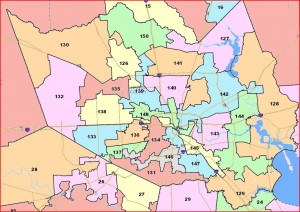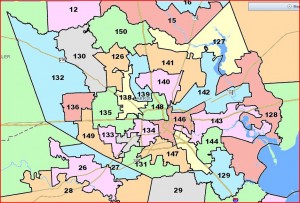The federal lawsuit that will be heard by a three-judge panel in San Antonio begins next week, but in the meantime there have been depositions taken by various players, and some interesting things have come up in them. Texas Redistricting highlights one of the assertions made by the Mexican American Legislative Caucus about the need for three new Latino opportunity districts in the State House:
The three new seats would be:
- a seat spanning Dallas and Tarrant counties (similar to HD 107 in Plan H205),
- a seat spanning Hidalgo and Cameron counties (similar to HD 144 in Plan 201), and
- a seat in West Texas (similar to HD 84 in Plan H 205)
To achieve these seats, MALC argues that the court should allow lines for state house seats in the DFW Metroplex and Cameron and Hidalgo counties to selectively cross county lines, notwithstanding the “county-line rule” in the Texas Constitution.
MALC argues that this result is mandated by the Voting Rights Act.
In addition to the three new opportunity seats, MALC argues that in both Harris and Nueces counties a currently existing opportunity seat should be preserved.
You can see MALC’s preferred vision for Dallas and Tarrant Counties in the preceding post. You will immediately notice that it has several districts that include both Tarrant and Dallas Counties, and that a piece of District 10 pokes into Dallas from Ellis County. The five counties in Texas that have over 1 million people in them – Harris, Dallas, Tarrant, Bexar, and Travis – do not share legislative districts with any other county. I’m not sure what the source of this is. The Texas Constitution, article 3, section 26, says:
Sec. 26. APPORTIONMENT OF MEMBERS OF HOUSE OF REPRESENTATIVES. The members of the House of Representatives shall be apportioned among the several counties, according to the number of population in each, as nearly as may be, on a ratio obtained by dividing the population of the State, as ascertained by the most recent United States census, by the number of members of which the House is composed; provided, that whenever a single county has sufficient population to be entitled to a Representative, such county shall be formed into a separate Representative District, and when two or more counties are required to make up the ratio of representation, such counties shall be contiguous to each other; and when any one county has more than sufficient population to be entitled to one or more Representatives, such Representative or Representatives shall be apportioned to such county, and for any surplus of population it may be joined in a Representative District with any other contiguous county or counties.
I found this presentation on the county line rule for apportioning House districts that adds some more information; Greg liveblogged a hearing at which this presentation was given, in which the presenter suggested that Dallas and Tarrant were “not sacrosanct from being carved out” to create a district with Ellis County. My presumption is that MALC picked that up and ran with it. What I have learned, thanks to Michael Li of Texas Redistricting patiently answering my annoying questions, is that the county-line rule is a matter of policy choice and not legislation or litigation. There’s nothing to require that Dallas reps are only in Dallas or Tarrant reps are only in Tarrant. It was a choice they made, and MALC is making the argument that they should have chosen differently to accommodate the burgeoning Latino population.
Along similar lines, the Plan H205 than Rep. Martinez-Fischer submitted gave Harris County 25 members as it now has. There’s another feature of this map that I’d like to point out. Here’s the map that was passed by the Lege and signed by the Governor for Harris County:
And here’s Harris County as Martinez-Fischer drew it:
The two districts that don’t show a number are 137 (the gray one in the southwest) and 145 (the yellow one to its east). As I see it, the MALC map has generally more compact districts. Certainly, there’s nothing like the abominations that are 145 and 148 in the state’s map. Personally speaking, I love the fact that MALC’s map leaves Super Neighborhood 22 whole, instead of chopping it into three pieces. I’m willing to bet that if you imposed a neighborhood map over either of these, MALC’s would be a better fit.
Anyway, just something to think about. I hadn’t really understood the county-line rule before, so this has certainly been educational for me. You can see a transcript of the depositions given by Rep. Martinez-Fischer and Rep. Veronica Gonzalez on behalf of MALC here. The trial gets underway next week, so we’ll see what happens.



Be VERY careful what you wish for here. Without the county-line rule the Republicans could quite easily create an additional 5 or more seats beyond what their map allows.